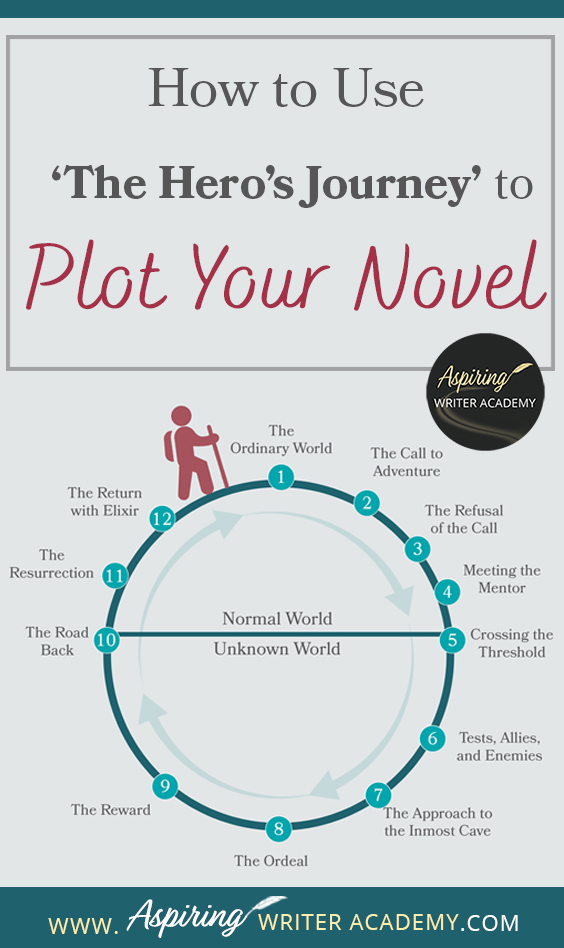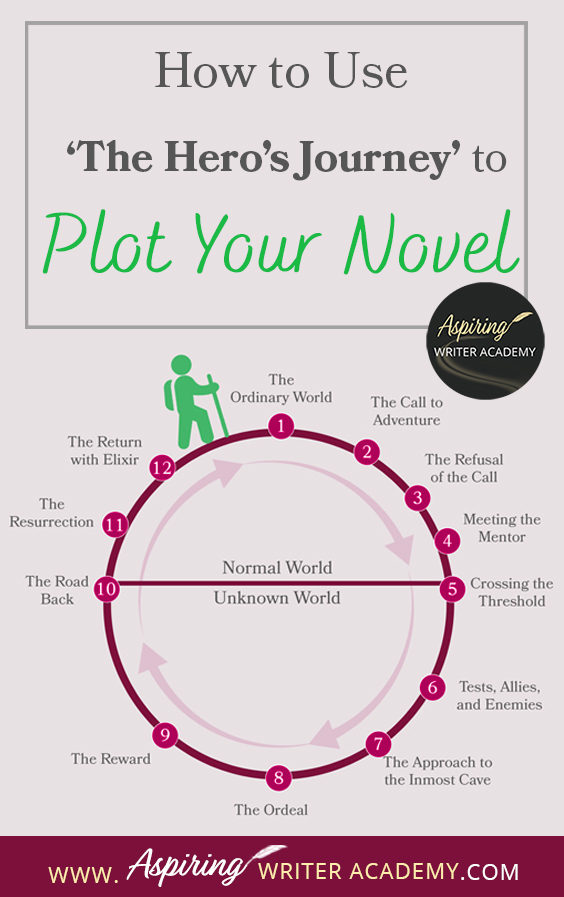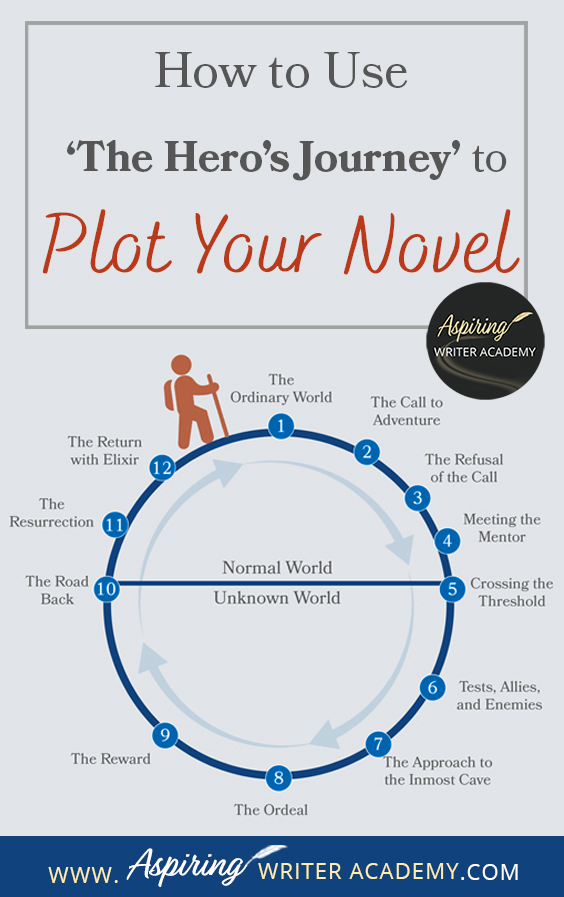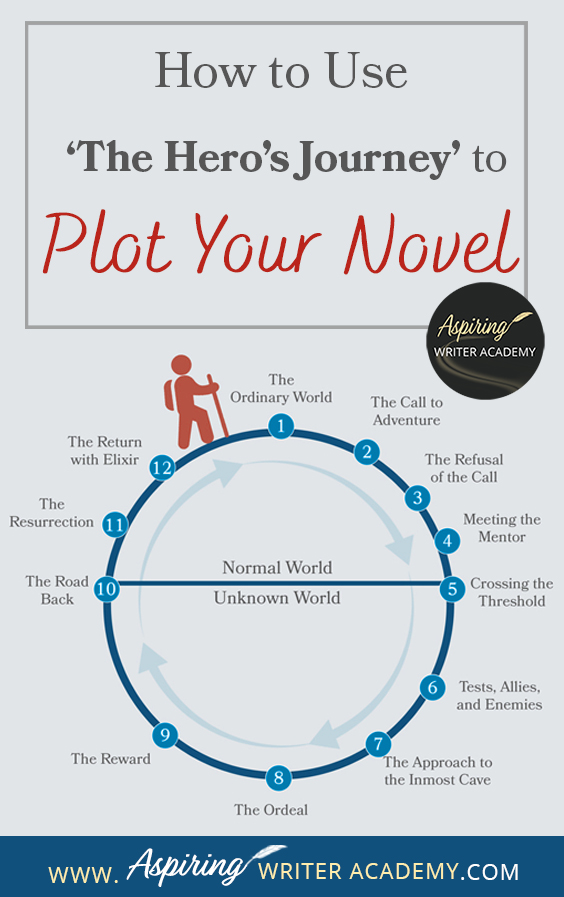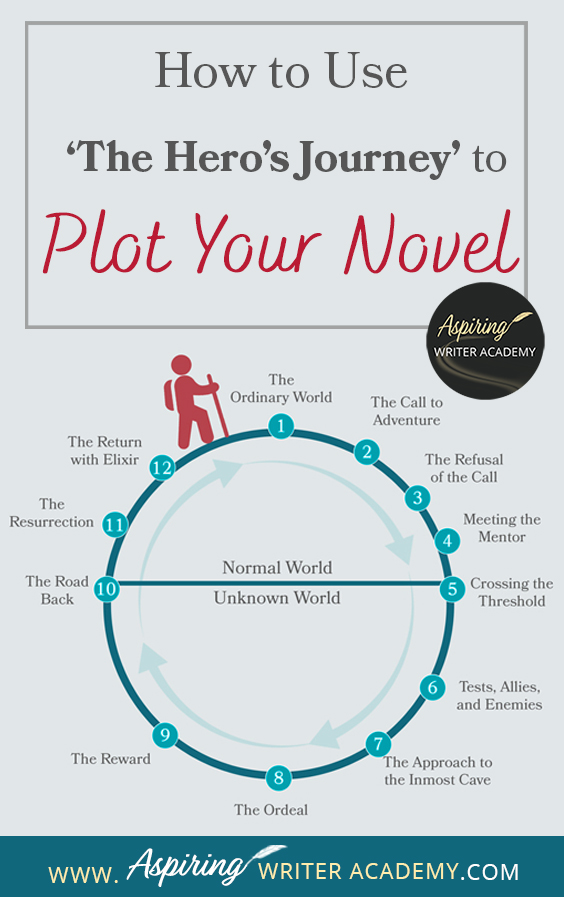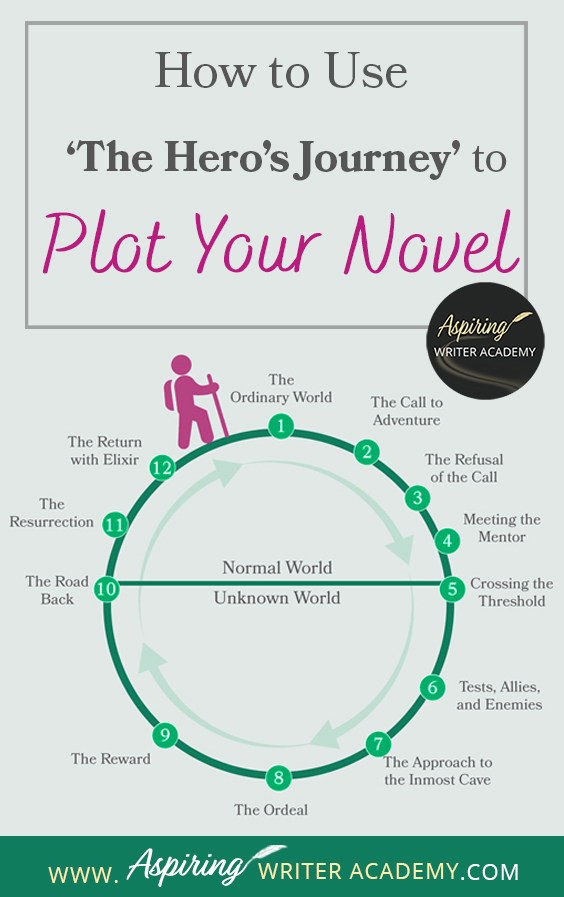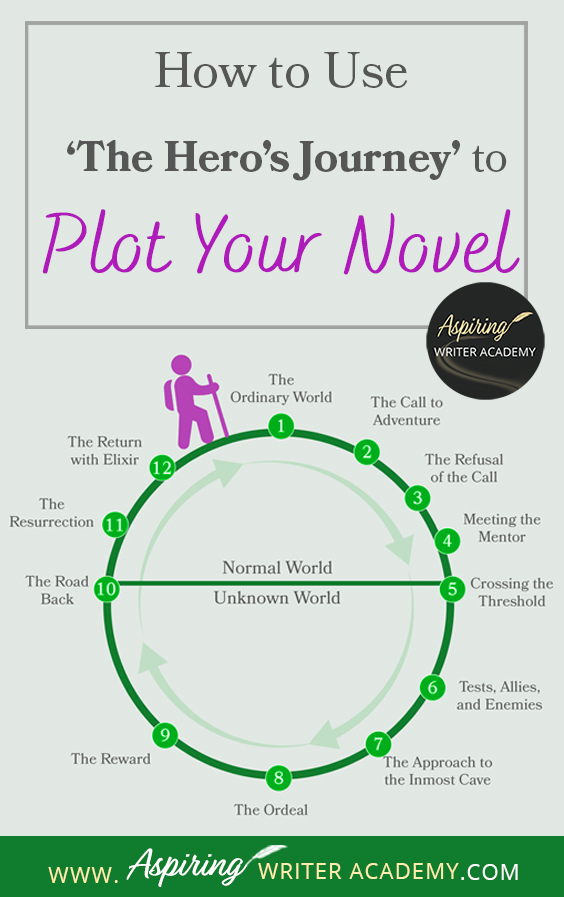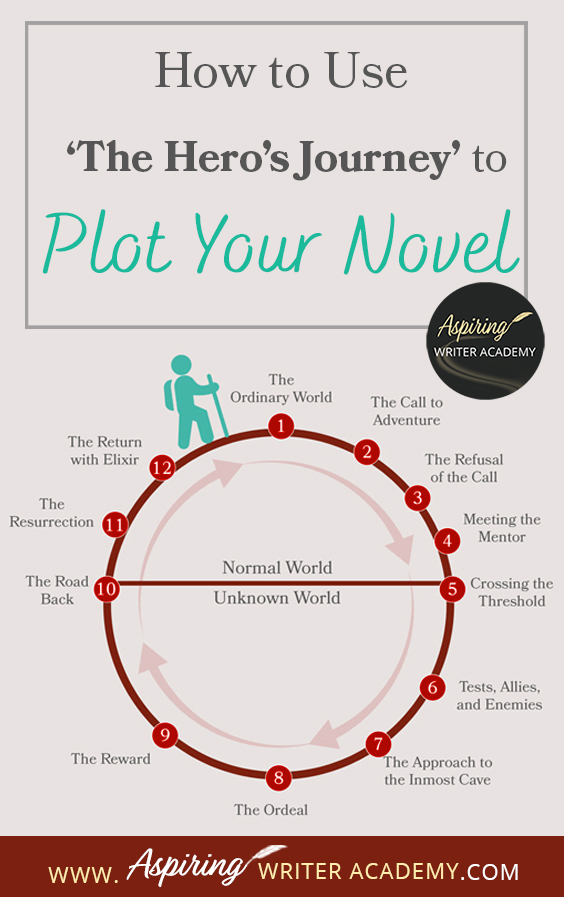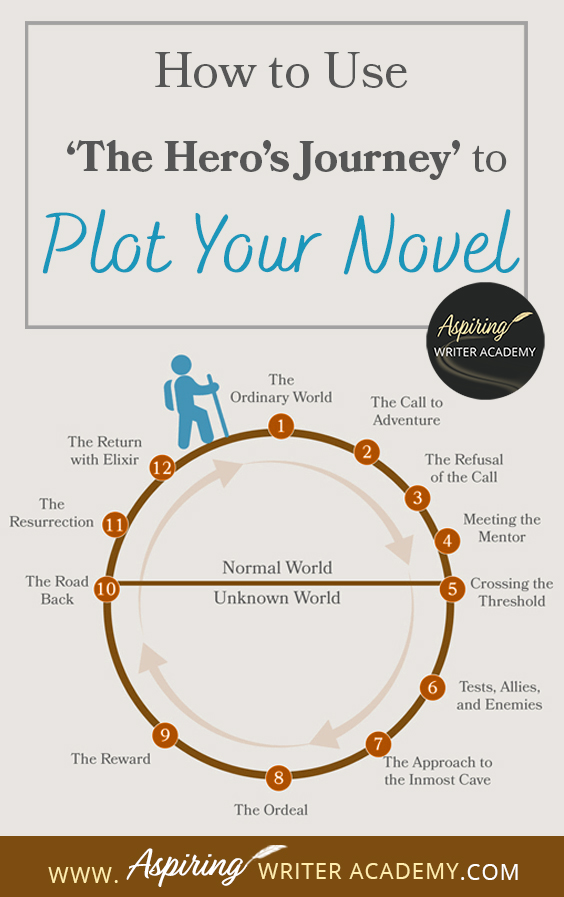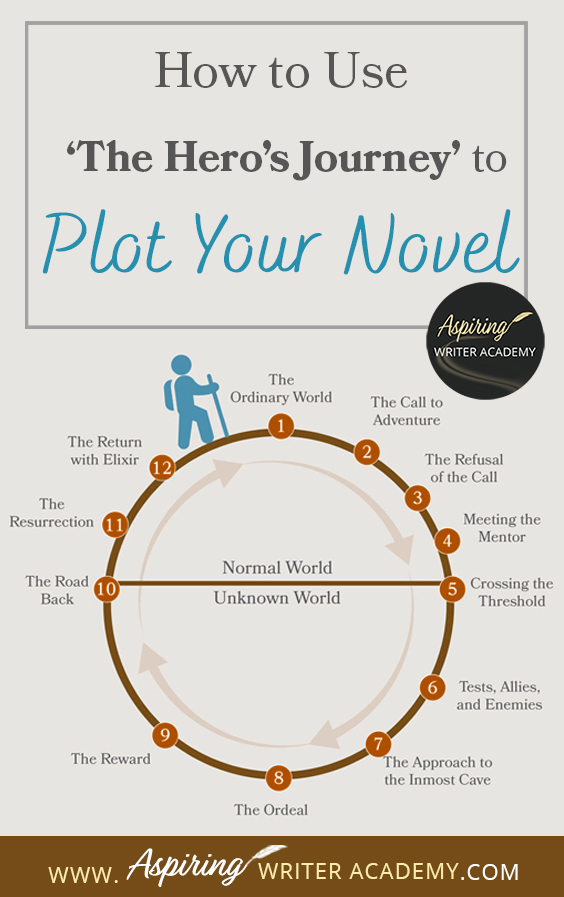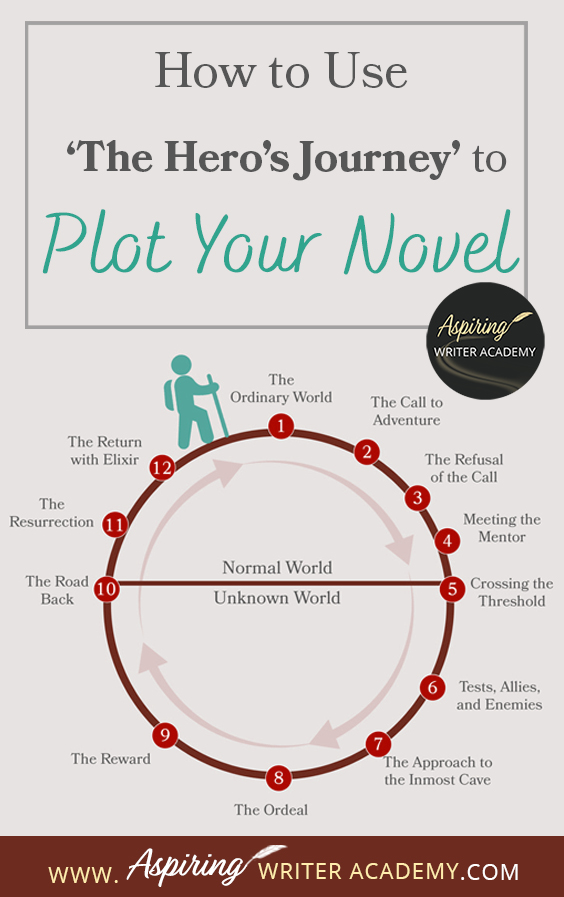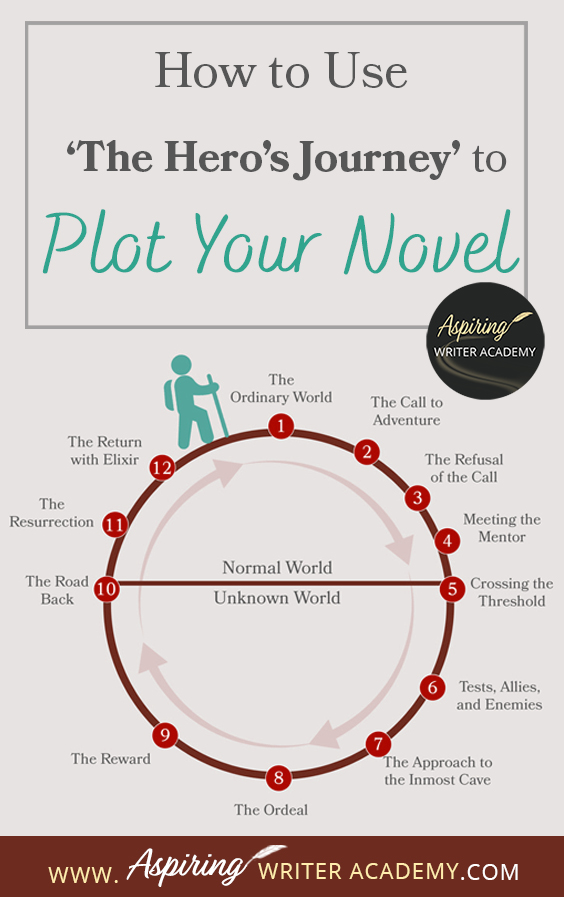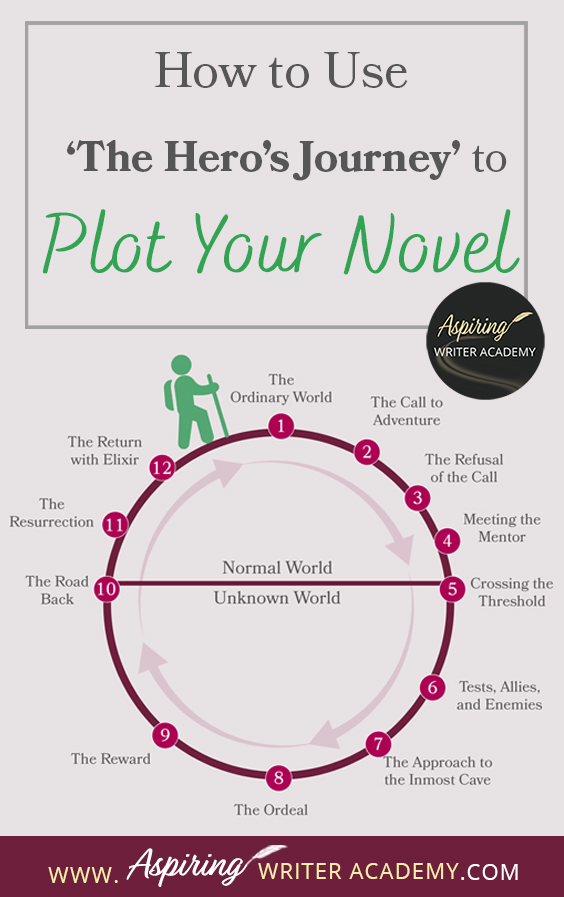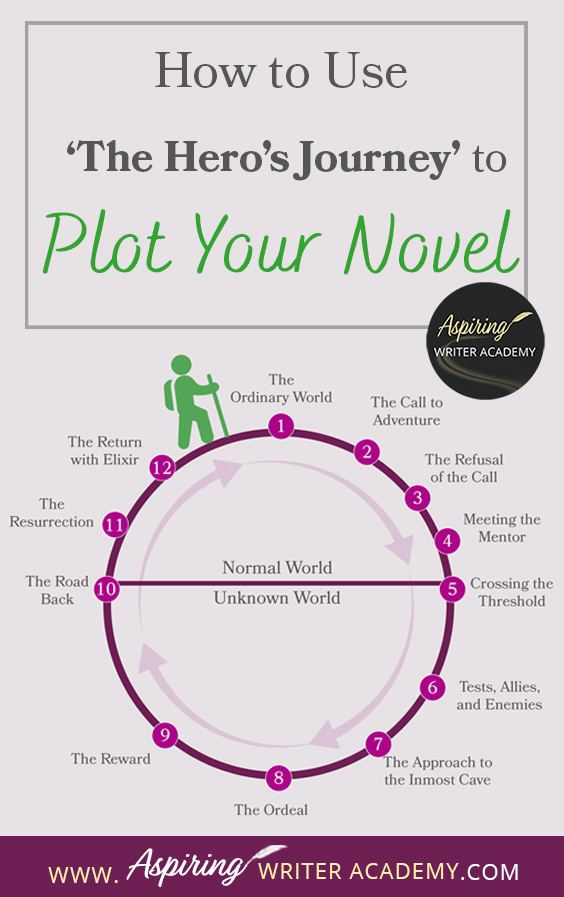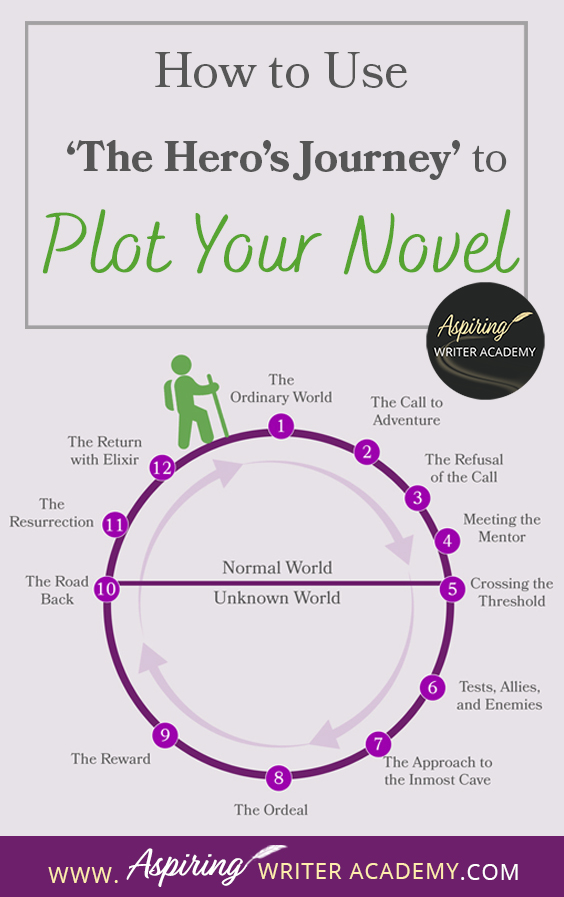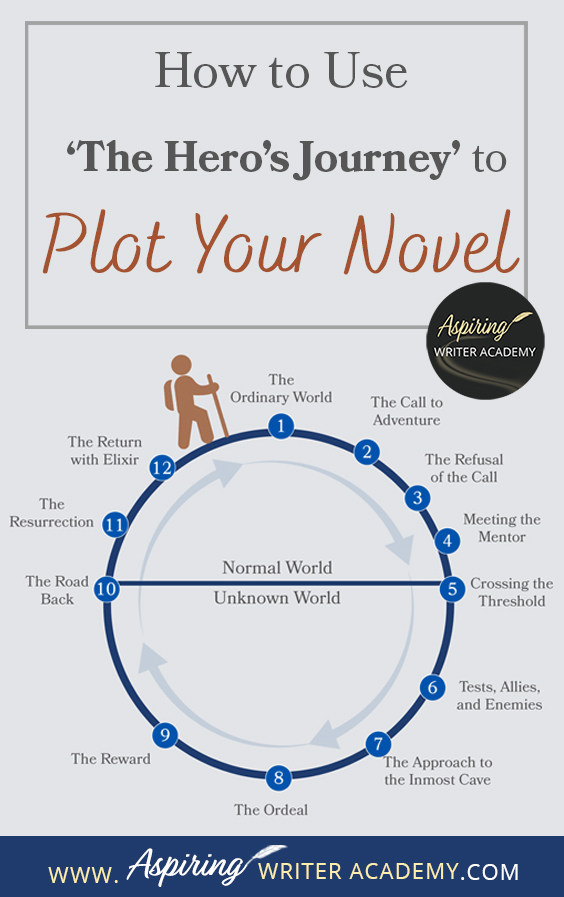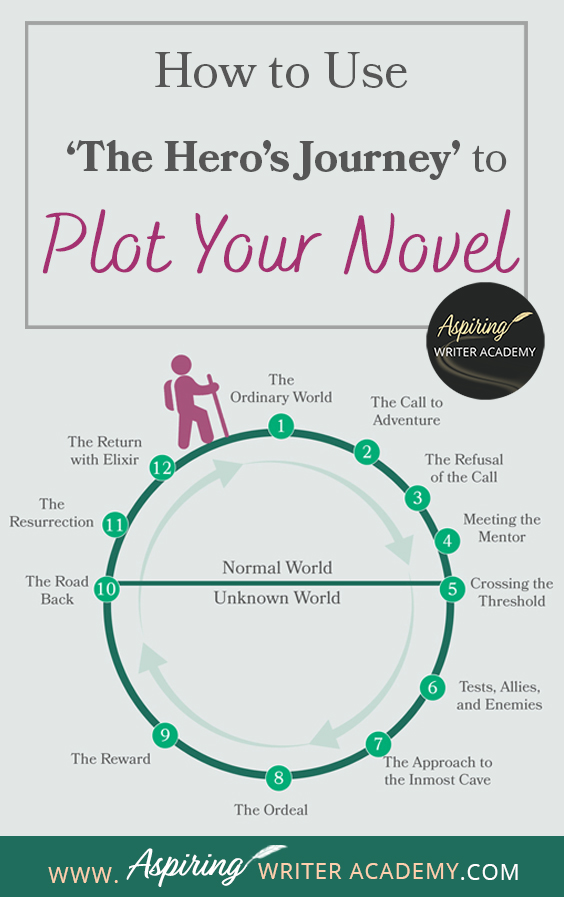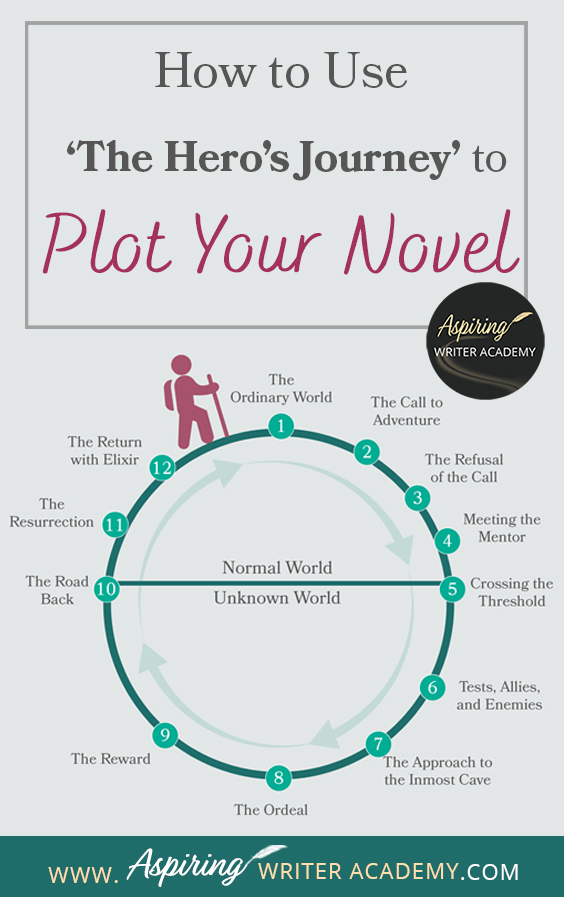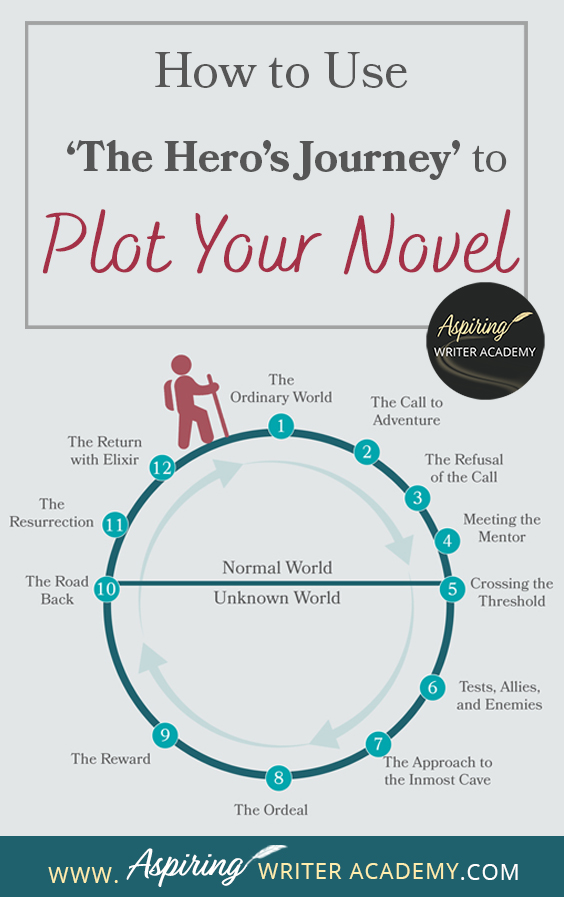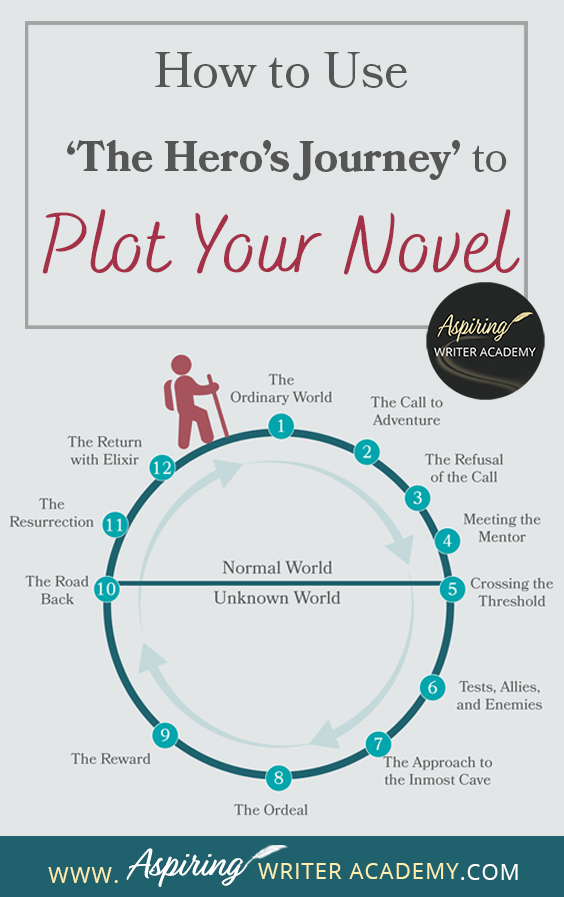How to Use ‘The Hero’s Journey’ to Plot Your Novel
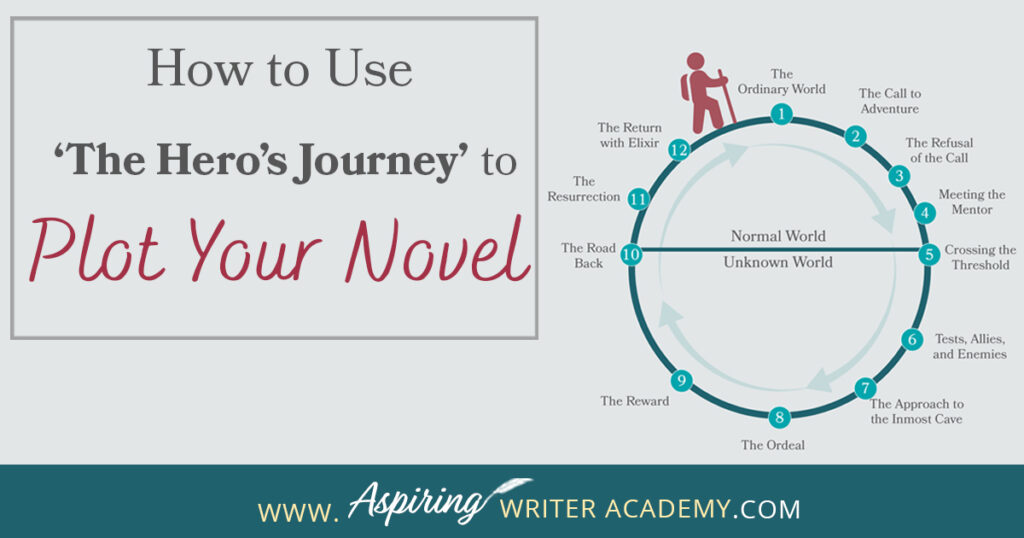
If you are writing a novel for the first time or are confused by 3-Act Structures and Plot Points, you may want to use the steps of The Hero’s Journey, first outlined by Joseph Campbell, as a guide. Learn how to take your characters on an epic 12-stage journey of transformation as they overcome obstacles and achieve their goals.
In How to Use ‘The Hero’s Journey’ to Plot Your Novel, we explain each step, allowing you to plot a stronger, emotionally satisfying story from beginning to end.
In this post on The Hero’s Journey, we will discuss:
- Ordinary World
- The Call to Adventure
- Refusal of the Call
- Meeting the Mentor
- Crossing the Threshold
- Tests, Allies, and Enemies
- Approach to the Inmost Cave
- The Ordeal
- The Reward
- The Road Back
- The Resurrection
- The Return

If you would like to pursue a writing career, at some point you will undoubtedly hear about a classic plot structure called, The Hero’s Journey, (also called a monomyth) which was first identified in Joseph Campbell’s book, The Hero With a Thousand Faces. According to Campbell, the monomyth has three major rites of passage: separation, initiation, and return. While his book was first published in 1949, The Hero’s Journey is a mythological archetypal story that has been used in literature and mythology around the world for centuries.
Updated editions of Joseph Campbell’s book continue to sell today.
While Campbell recognized 17 story beats in The Hero’s Journey, screenwriter Christopher Vogler condensed it down to 12 steps in his book, The Writer’s Journey, published in 2007. If you can, try to attend one of his classes at various writer’s conferences.
It is this 12-step method that has become most popular with writers today.
What is ‘The Hero’s Journey?’
The Hero’s Journey is a classic plot structure where a fictional character goes on a quest or adventure, overcomes obstacles to achieve a goal, and returns home transformed.
Learning the 12 Steps of The Hero’s Journey was a game-changer for me. Without second-guessing myself, I now had a map, a complete path (or gameplan) to write my fictional novel from start to finish. You, too, can use The Hero’s Journey to create riveting stories that resonate with readers around the globe by using universal themes such as self-discovery, transformation, and growth, no matter what genre you write.
Ready to get started?
The 12 Steps of The Hero’s Journey
1. The Ordinary World
The opening scenes of your fictional novel show the main character (hero/heroine) interacting with their ordinary (or what is ordinary to them) world. If the story takes place on another planet, show the hero’s everyday ordinary life in this setting. Let us see the hero’s personality, strengths and weaknesses, habits, quirks, and fears and dreams for the future. This helps the reader connect with this character and empathize with his predicament when he’s hit with the big changes to come.
2. The Call to Adventure
Often known as the ‘Inciting Incident’ in other plot structures, the hero’s life changes when he receives a call to action. An opportunity is presented to him or a disaster hits that he must figure out how to overcome. This is a game-changing moment that could threaten his safety, his family, or his entire ‘world.’ The hero will need to leave the comfort of his ordinary life or way of being to solve this big problem or to go on this quest or story adventure. Perhaps an antagonist has launched an attack on the hero, instigating a dilemma the hero must now solve. The ‘Call’ can come in the form of an unexpected phone call, a letter, or from a mentor or someone showing up at the door.

3. The Refusal of the Call
At first, the hero may be reluctant to take action or go on this adventure. He would prefer to stay put due to fear, doubt, or feeling inadequate to take on such a task. Overcoming this major obstacle or taking on the challenge presented to him is not something he wants to do or feels he can do. Or it could be another character who tries to dissuade the hero from accepting the call to adventure, begging him to reconsider.
4. Meeting the Mentor
A mentor, guide, or individual offering wisdom shows up to help dispel the hero’s insecurities and encourages him to take action. The mentor can help the hero understand the consequences if he does not accept this Call to Adventure. The mentor can advise, train, or equip the hero with what he needs to begin his journey.
5. Crossing the Threshold
The hero leaves his comfort zone, his ordinary world, or old way of living behind. He steps into new unknown territory, whether it be a physical, spiritual, or an emotional challenge. He is now committed to the journey and will need to learn new skills to navigate his new situation and overcome the obstacles in his path. There will be no turning back from this point on. He will have to face whatever his journey brings.
6. Tests, Allies, and Enemies
The hero will encounter a series of problems and challenges that will expose his strengths and weaknesses and test his will to continue onward. He may meet allies who can help, and enemies who thwart his efforts. The hero may have to learn whom he can trust. The antagonist or opposition in your fictional story will continue to throw obstacles in the hero’s path to try to stop him from achieving his goal. If the challenge is a physical hurdle the hero must overcome, such as an illness, there will be unexpected complications and setbacks. As a result, the hero grows in character, develops new skills, and is strengthened to face even greater challenges in the future.

7. The Approach to the Inmost Cave
The hero takes time to reflect on his journey thus far and consider what lies ahead. Often, in films, the hero may enter an actual cave or venture into a dark ‘cave-like’ place to ponder his next steps. A huge challenge lies ahead, and the hero must summon his courage to take the steps necessary to meet that challenge. This is a time of preparation.
8. The Ordeal
The hero is presented with a pivotal challenge inside this new special world he has entered on his journey which forces him to face death or his greatest fear. He uses his newfound skills and knowledge to meet this challenge, and he is changed by the experience, which prepares him to continue the journey. Facing his fears gives him strength. This stage might also have your hero facing an inner crises or personal weakness that he needs to overcome. This is not the final confrontation with the opposition but a clashing of swords or dangerous fight. The hero might think he’s attained his goal, but his journey is not finished quite yet.
9. The Reward
The hero emerges from the ordeal stronger than he was before and often he receives a prize that will help him on his quest or adventure. This reward could be new information, an object of importance, a secret revealed, or reconciliation with an ally or loved one.
10. The Road Back
The hero has attained the prize and begins the journey back, but he may encounter new obstacles that he must circumvent. Many times, this may involve a chase scene from those trying to stop him. Or he may be presented with another whole set of challenges he didn’t anticipate. The hero may have to choose between his personal goal and one he now deems better. Or perhaps sacrifice the prize for a greater purpose, such as to help a loved one.
11. The Resurrection
The hero faces either a physical or metaphorical transformation of death and rebirth. This is the climax, the hero’s final face-to-face confrontation with the opposition where the hero will either emerge victorious or he will not. The hero must use all the knowledge, skills, and experiences he’s learned on his journey to overcome his fears or shortcomings and defeat the opposition once and for all. The fate of others is contingent on the outcome and if the hero fails, others will be negatively affected as well, giving the hero even more reason to push on. His old ‘self’ is transformed into a better new version of himself, giving him the means to succeed and defeat the opposition.
12. The Return with Elixir
The hero returns home to his ordinary world, changed by his arduous adventure. He has defeated the enemy, overcome many challenges, faced fear and death, and has come back with a new perspective and hope for the future. The change in the hero may inspire change in those around him or within his community. Or the hero may bring back gifts to bless the community. The Elixir, the hero’s final reward, may be proof of his success. This could be a treasured object he obtained in his quest or perhaps he gains the respect he most desired from a loved one, etc. The journey home also leads to the story resolution where the hero’s allies are rewarded, and his enemies punished. The hero returns home, but now things will be different, better in some way than before he left. He is free to live his best life.

Final Recap:
The Hero’s Journey is a timeless story pattern where the hero is presented with a challenge or ‘call to adventure’ that requires him to leave his ordinary world behind to venture into unknown territory (leave his comfort zone.) He is then tested, forced to face his fears, and gains new skills and allies to help him overcome various obstacles before confronting a major enemy, crisis, or story problem, after which the hero returns home, transformed, changed by the experience.
We hope you have enjoyed How to Use ‘The Hero’s Journey’ to Plot Your Novel and that you have gained some valuable tips to outline your fictional novel from beginning to end.
If you have any questions or would like to leave a comment below, we would love to hear from you!
If you like more help developing your story, you may wish to download our Free Brainstorming Your Story Idea Worksheet
Do you find it difficult to create compelling antagonists and villains for your stories? Do your villains feel cartoonish and unbelievable? Do they lack motivation or a specific game plan? Discover the secrets to crafting villains that will stick with your readers long after they finish your story, with our How to Create Antagonists & Villains Workbook.
This 32-page instructional workbook is packed with valuable fill-in-the-blank templates and practical advice to help you create memorable and effective antagonists and villains. Whether you're a seasoned writer or just starting out, this workbook will take your writing to the next level.
We Believe All Authors Can Aspire to Take Their Writing to the Next Level!
Our Goal for Aspiring Writer Academy is to help people learn how to write quality fiction, teach them to publish and promote their work, and to give them the necessary tools to pursue a writing career.

ENTER YOUR EMAIL BELOW
TO GET YOUR FREE
"Brainstorming Your Story Idea Worksheet"
7 easy fill-in-the-blank pages,
+ 2 bonus pages filled with additional story examples.
A valuable tool to develop story plots again and again.
Other Blog Posts You May Like
10 Tips for Using Flashbacks in Your Fictional Novel
How to Use Framing Techniques in Your Fictional Novel
How to Write a Novel with the W-Plot Template
How to Use Themes in Your Fictional Story
Fiction Writing: What is a Pinch Point?
7 Tips for Writing a Story Synopsis
Fiction Writing: What is the ‘Black Moment?’
Fiction Writing: What is the ‘Man in the Mirror Moment?’
Fiction Writing: What is a Plot Hole?
How to Write Act III and Finish Your Fictional Story in 5 Steps
Structuring Act II (Part 2) for Maximum Impact: How to Keep Readers Engaged
Structuring Act II (Part 1) for Maximum Impact: How to Keep Readers Engaged
How to Use Setting to Intensify Your Fictional Scenes
How to Manipulate Pacing to Increase the Intensity of Your Scenes in a Fictional Novel
How to Brainstorm a New Novel Using Goal, Motivation, and Conflict
Fiction Writing: How to Plot a Story where the Antagonist is an ‘Invisible Foe’
Fiction Writing: Create a Storyboard to Map Out Your Scenes
3 Ways to Avoid Writing ‘Episodic’ Scenes in Fiction
How to Write Act I: Opening Scenes for Your Fictional Story
Brainstorming Fiction: What to Do When Your Story Gets “Stuck”
How to Plot Your Fictional Novel (with Free Template Included)
5 Questions to Create Believable Villains
Why Your Characters Need Story-Worthy Goals
How to Captivate Your Readers with Scene-Ending Hooks
Scene & Sequel: The Secret to Plotting an Epic Novel (Part 2)

is a multi-published author, speaker, and writing coach. She writes sweet contemporary, inspirational, and historical romance and loves teaching aspiring writers how to write quality fiction. Read her inspiring story of how she published her first book and launched a successful writing career.

